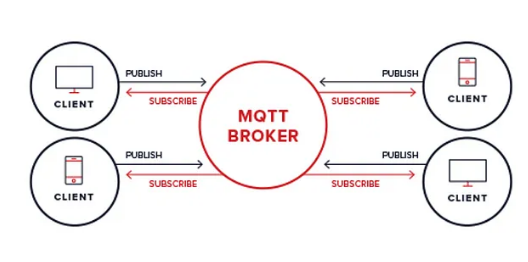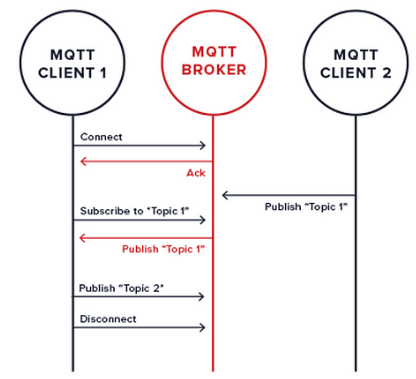
Author: Free and Open Lake AI
What is MQTT Used For?
MQTT is a lightweight messaging protocol commonly used for Internet of Things (IoT) devices, designed to be energy-efficient and consume minimal bandwidth.
The MQTT protocol operates over TCP/IP and is based on a lossless communication bi-directional publish-subscribe model, ensuring that MQTT messages are delivered efficiently and without loss.
MQTT is a low-overhead protocol that strongly considers bandwidth and CPU limitations. Its design allows it to operate in embedded environments, providing a reliable and effective communication pathway.
Fundamentally, MQTT is a publish/subscribe (pub/sub) protocol. It allows clients to connect as publishers, subscribers, or both to specific topics. You connect to a broker that handles all messaging, with each client identified by a unique client ID.
Examples and Use Cases of MQTT in Real Life
MQTT is often used in IoT applications to connect and communicate with low-power devices such as sensors, actuators, and home appliances, effectively managing the payload of transmitted data.
In agriculture, MQTT is used to monitor environmental factors such as soil moisture, temperature, and humidity, enabling farmers to take appropriate actions. In industrial automation, MQTT can monitor end-to-end manufacturing processes, ensuring consistent quality and identifying systemic issues in the production chain. In transportation, MQTT is used to monitor traffic lights, parking meters, and the real-time location of public transport, while being mindful of ecosystem and low bandwidth requirements.
Why Use MQTT Instead of HTTP?
HTTP and MQTT are two distinctly different communication protocols used for different purposes.
HTTP is a request/response protocol that only transmits data in response to client requests. It is designed for large amounts of data and is typically used for transmitting web pages, images, and videos. MQTT is a publish/subscribe protocol that supports asynchronous messaging, allowing multiple clients to subscribe to a single topic and receive messages from one or more publishers. MQTT is optimized for small amounts of data, making it more efficient than HTTP in terms of network overhead and device power consumption, making it a suitable choice for applications requiring low bandwidth and minimal power consumption (e.g., applications managed by AWS IoT services).
What Language is MQTT Written In?
MQTT is just a protocol and can be implemented in various programming languages. However, MQTT client libraries for communication using the MQTT protocol support multiple languages, including C/C++, Java, Python, and JavaScript, as well as Node.js, Ruby, Go, PHP, and Swift. MQTT client libraries communicate through MQTT brokers, which also have versions in various programming languages.
How Does MQTT Work?
MQTT is a very flexible protocol, but it has only two basic entities: the MQTT client and the MQTT broker.
How Does the MQTT Client Work?
An MQTT client can be any endpoint that implements the MQTT protocol. In the context of IoT, clients are connected devices such as sensors, displays, or Arduino boards, but MQTT is not limited to IoT; for example, clients can also be smartphones or laptops.
MQTT clients do not communicate directly with each other. Instead, all interactions are mediated by a server component called the MQTT broker, which sits between clients and handles message routing.
What is an MQTT Topic?
All communication in MQTT is divided into “topics.” MQTT clients can publish messages to a topic or subscribe to receive messages from others. Topics can be any string, designed to group messages of common interest, such as sensor updates published to a topic, or messages in a group chat, depending on the use case.
What is an MQTT Broker?
The broker is responsible for managing which clients are subscribed to which topics, receiving messages published on specific topics, and sending those messages to any clients subscribed for updates. The broker is also responsible for caching messages when the connection between the client and broker is lost and delivering them to the client when the connection is re-established.
What MQTT Brokers Can Be Used?
MQTT brokers are the foundation of the MQTT protocol and can be viewed as MQTT servers. As mentioned, brokers sit between all clients and facilitate communication.
There are many MQTT brokers available, both open-source and proprietary, and one of the most important architectural decisions in any MQTT-based deployment is how to host the broker. Since MQTT is designed to operate at a very large scale, any broker architecture needs to scale accordingly. Most enterprise deployments will rely on cloud-hosted proprietary products, so they do not face infrastructure issues, although self-hosted options are also available.
Between all communications, the broker can retain messages and maintain a secure record of all sessions; clients are isolated from each other, so insecurities and vulnerabilities in one client can be sandboxed, and depending on your network topology, the broker can reduce traffic across the entire network and allow for more efficient routing.
How to Use MQTT and Pub/Sub
Any client that supports the MQTT protocol can subscribe to and publish topics, but all communication is done through the broker, as shown in the example model below.

Features of the MQTT Protocol
While MQTT is often considered an IoT solution, it is the protocol that underpins many well-known IoT products. Many features of MQTT make it particularly suitable for efficient communication between devices:
Easy to Start and Run
MQTT has been around for a long time and has many robust, reliable, and scalable proprietary and open-source solutions. These pre-existing MQTT components can be used for all projects, from large solutions to passion projects, without modification, regardless of developer experience.
Reliability and Configuration
MQTT has the concept of Quality of Service (QoS), which will be discussed in detail later, that queues messages and caches them on the MQTT broker, delivering them to clients upon reconnection. This is particularly useful for devices with partial connectivity or clients with intermittent connections, such as IoT devices.
Clients Do Not Have to Worry About Solution Architecture
With MQTT, messages can be published to topics and received when available. As a client, you do not have to worry about establishing or re-establishing connections, nor do you have to worry about whether the recipient is listening to your messages; it “just works.”
Designed for Scale
MQTT can handle any scale your solution requires, from startups to global companies. Notably, Facebook Messenger uses MQTT for communication.
MQTT Session Lifecycle
MQTT relies on TCP/IP for connections, thus following a similar lifecycle.
Connection
The MQTT client initiates a connection with the MQTT broker. Typically, this will be through the standard MQTT ports (1883/883 for secure and insecure connections, respectively).
Authentication
The MQTT protocol has no authentication considerations beyond the TLS of the underlying TCP/IP connection, which is sufficient for most use cases.
Publish/Subscribe
Once connected, clients can publish or subscribe to topics to send and receive messages.
Disconnection
Disconnection can be initiated by either the client or the broker and will result in the MQTT session ending after processing any ongoing requests.

MQTT Quality of Service (QoS)
Quality of Service allows solution designers to specify the reliability of MQTT connections; generally, the more reliable the connection, the greater the potential memory overhead for retries and message retention.
QoS 0
Messages are sent only once, and neither the client nor the broker takes additional steps to confirm delivery. This is also known as “fire and forget.”
This applies only to messages sent by the client. Once received by the broker, they are considered QoS 0.
QoS 1
A handshake occurs between the sender and receiver to ensure that only one copy of the message is received. This ensures delivery and avoids multiple copies of the sent message.
QoS 2
Messages will be resent multiple times until the recipient confirms receipt. This is most suitable for time-sensitive messages but may result in duplicate messages being received.
MQTT Use Cases and IoT
MQTT is a lightweight and energy-efficient protocol that has been used in solutions where these factors are key considerations for many years.
The Internet of Things (IoT) is one of the most popular examples where MQTT is particularly well-suited. IoT devices are often battery-powered, and maintenance costs can be very high, so it is best for them to last a long time between battery replacements. While it is not difficult to replace batteries in a home environment, in industrial settings, there can be thousands of sensors spread over vast areas, often located in very hard-to-reach places, making maintenance quickly become expensive.
MQTT IoT use cases include fire detectors, theft tracking, location monitoring, sensors, engine status, and more. MQTT also has very low data overhead, making it an ideal choice in environments where data costs are high or where thousands of devices are deployed.
PubNub and MQTT can work well together in IoT. Please see our IoT demo and IoT tutorial for more details on how PubNub and MQTT provide reliable, scalable, and efficient IoT solutions.
MQTT is also very popular in real-time communication, with the most notable example being Facebook Messenger.
Why Did Facebook Choose to Use MQTT?
Because it does not drain the phone’s battery, does not use excessive data, operates over secure protocols, allows for scalability, easily facilitates group chats, and distributes all data through a central MQTT broker infrastructure.
END
Official Site: www.linuxprobe.com
Linux Command Collection: www.linuxcool.com

Teacher Liu Chuan QQ: 5604215
Linux Technology Group: 2636170
(New group, hotly joining…)
Readers who want to learn the Linux system can click the “Read the Original” button to learn about the book “Linux Should Be Learned This Way,” which is also very suitable for professional operations personnel to read, becoming a high-value tool book to assist your work!